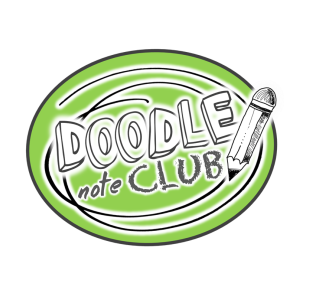
We know that hands-on, printed doodle notes are the best for engaging students’ brains and getting the full benefit of visual note taking. But sadly, in todays’ schools, copy limits seem to be getting stricter and stricter. Great for the environment- not so great for the teacher who loves doodle notes the “old-fashioned” way (with all the colored pencils and paper).
Or some days, you might have a million and one things to do, with no extra time to run to the copier. Whatever your reason, sometimes it’s just not possible to make a copy of your doodle notes for every single one of your students.
So, what do you do?
Try taking a break from making copies, wasting paper, and using up expensive printer ink. Some days the following formats are more desirable, convenient, or just plain necessary for a successful class!
Here are some ideas for you if you yearn to use doodle notes, but can’t make copies for the entire class right before the lesson!
Digital Doodle Notes
A friend of mine, Leah at leahcleary.com, provided an excellent post about how to make your worksheets work digitally. It’s actually much simpler than you may think!
First, a disclaimer: I strongly believe in doing notes by hand, on paper, whenever possible! (See this post on digital classroom vs. math by hand.)
But of course, there are times when digital lessons can be wonderful and practical. So, the goal here is to do the best you can to maximize the brain benefits in any situation.
Here are the steps to get your doodle note sheets into a digital format.
You need to follow a few very simple steps:
- Make sure your worksheet is in PDF format. (Hint: you can do this with your smartphone! Simply take a picture of the worksheet, save it as a PDF, and email it to yourself.)
- Have students add the free app DocHub to their Chrome accounts. You should have DocHub, as well.
- Assign students the doodle note sheet (or background template that you have pre-selected to work well with the lesson content) through email or the online platform of your choice. Even if you don’t have Google classroom, you can do this!
Then, with their devices, students have easy access to the note pages (or worksheet). With DocHub, they can draw, write, highlight, and even insert text or images on their note sheet!
For a more in-depth explanation and more tips and tricks for paperless doodle notes, check out this blog post- Making Visual Note Taking Work Digitally.
Be prepared with general templates on hand
Before school starts for the year (or whenever you have some free time or extra copies), build a stockpile of templates that can be used for any lesson. Then, when you run into days like these when you can’t make more copies, you already have doodle notes on hand and ready to go!
This FREE set of doodle note templates includes 5 different free pages with simple, basic layouts for sketch notes, doodle notes, or other visual note-taking strategies. Some time before your lesson, sit down and determine which layout works best and create a teacher copy for students to use as a reference!
Have students build their own layouts with DIY Doodle Note Stickers
Similar to the previous tip, you’ll want to have a stockpile of DIY Doodle Note Stickers ready to go!
(Click here to download a free starter set.)
Distribute stickers to the students, and let them assemble their own pages right inside their notebooks.
To make this easy, two versions are included for many of the larger structural stickers. You can choose to print a variety pack for each child, or you can print the versions that have 4 of the same sticker on each page. It’s easy to just pass out a single page for a whole table of four students, and it saves paper!
Remember, if you don’t want to purchase sticker paper, you can just use regular paper and have kids glue these into their notebooks.
For a more in-depth blog post about these stickers, go here.
Create your own “dry-erase” doodle notes
Laminate a small number of copies of a doodle notes set, so that they can be used with dry erase markers.
Have your students complete them at a station or in a small group, so you don’t need too many copies. Then, have them erase for the next student.
The downside of this method is that they won’t have their doodle note sheets to refer back to, so this would work best as a quick review with the small graphic organizer cards, or simple sketches to check knowledge. You also need fine tip dry erase markers in a variety of colors, so students are getting those brain benefits!
What do you think? Have you tried any of these formats? Let us know in a comment what worked for you and what didn’t!
